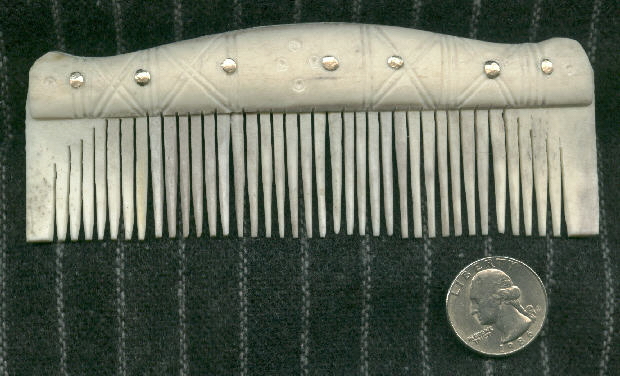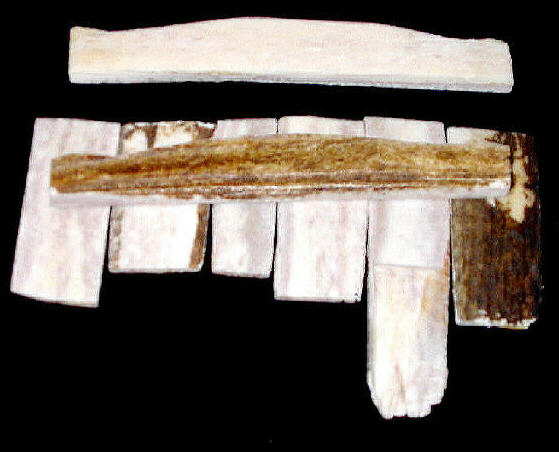 |
Kynnabaria |
The completed comb! (well... it could use some more work pointing the teeth...)

Parts cut out and starting to fit together:

The goal for this project was to make a composite simple comb in a style of late tenth century Scandinavia for my wife. Hundreds of Viking Age combs have been unearthed at sites in continental Europe and the English Isles, with over three hundred found at Birka alone. Comb design and decoration conveys some regional and chronological information. The chosen comb design was Ambrosiani type B3, which is distinguished by the presence of ring-dot decoration on the connecting plates. It suggests the owner was from or had contact with tenth century Denmark. I did not make a comb case because at Birka comb cases were only found in men's graves. While I was working on this comb, Frojel Gotlandica published their excellent gallery of viking and medieval combs. Dan Carlson and company are doing wonderful work, and the price of the CD is well worth it; furthermore, purchases further their efforts on their next project. Their bead CD is excellent as well.
In my opinion a composite comb is not a good choice for a first project in antler. Compared to other materials antler is difficult to work with; for example it's bad for your lungs and it doesn't come in standard sizes. Antler is also impressively tough stuff- as an experiment I carved some red oak with an antler blade! (It lost its edge quickly, though) Last, a composite comb requires careful work to fit a half dozen parts as well as control tooth spacing.
Type B combs were found more often in the upper layers of the Birka dig (type A combs were more common in the lower layers). Based on other grave jewelry and numismatics, Ambrosiani proposed the following chronology for comb types:

Therefore the comb is, broadly, a 10th century Swedish comb.
Comparing current animal habitats to inferred comb type origins suggests that comb types may have originally been influenced by local available material. Ambrosiani suggests that A type combs originated in Norway and Sweden, while B type combs originated in Denmark. MacGregor shows that moose antler is presently more common in Norway and Sweden, while red deer antler is more common in Denmark.
|
Comparison of Moose Habitat to Comb Type A Origins |
|
|
Moose
Broad, flat antler Habitat includes Norway & Sweden |
|
|
Type A Comb broader, flatter connecting plates Originated in Norway & Sweden |
|
|
Comparison of Red Deer Habitat to Comb Type B Origins |
|
|
Red Deer
Rounded antler Habitat includes Denmark |
|
|
Type B Comb
rounded connecting plates Originated in Denmark
|
|
[1] The Viking World, James Graham-Campbell. Ticknor & Fields, 1980.
[2] Viking Age Combs, Comb Making and Comb Makers, Kristina Ambrosiani. Stockholm Studies in Archaeology, 1981.
[3] Bone, Antler, Ivory and Horn: the technology of skeletal materials since the roman period, Arthur MacGregor. Totowa: Barnes and Noble, 1985.
[4] The Mästermyr Find: a viking age tool chest from Gotland, Greta Arwidsson and Göst Berg. Larson Publishing, 1999.
[5] "Viking and Medieval Combs," edited by Dan Carlson. Arkeodok, 2002.
[6] Birka I: Die Graber, Holger Arbman. Almqvist & Wiksells, 1943.